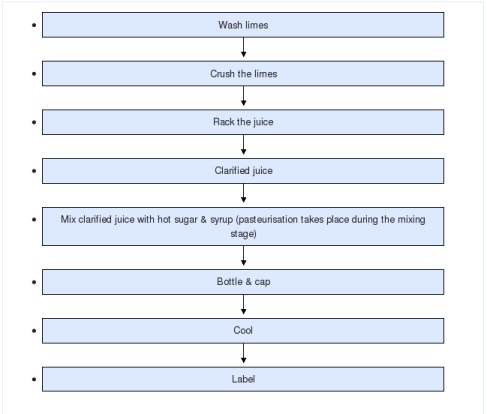Production
This Technical Brief describes a manufacturing system capable of producing up to 250 bottles (26oz each) of lime juice cordial per day using simple, comparatively low-cost equipment.
Lime juice cordial is a crystal clear product, normally sweetened with sugar, which is diluted to taste on serving. The product is preserved with sulphur dioxide (SO2) which also protects it against colour changes with time. The essential manufacturing steps involved are as follows:
Lime juice is very acidic and it is important that workers are provided with protective gloves to avoid damage to the hands. Only inert materials can be used to process lime juice as it will rapidly corrode steel. Stainless steel, plastic, glass and wood are recommended.
At small-scale, simple hand-squeezers can be used to extract juice but the yields obtained will be a lower than those obtained from the heavy stone roller-crushers or screw-presses used in large plants. A small-scale wooden roller press was developed and used with success in Sri Lanka. This press (shown diagrammatically in Figure 1) consists of a hopper that feeds lime fruits that have previously been cut in half, between two rotating hard wood rollers. The rollers are grooved along their length and rotate inwards powered either by hand or electric motor. One roller is of a slightly larger diameter than the other which provides a shearing action as the fruit passes through. The gap between the rollers can be adjusted and maintained by heavy springs.
The production of lime cordial requires the juice to be clarified in order to produce a crystal clear final product. Crude juice contains fruit debris and a cloud caused by fruit pectins. The raw juice squeezed from the limes needs to be 'racked' - or allowed to clear thus allowing the crude solid pulp to settle. Calcium carbonate is added at this stage. This reacts with the fruit pectins and produces calcium pectate which settles with fruit solids.
In order to preserve the juice during this settling time, sodium metabisulphite must be added at the rate of 3g/litre to provide a sulphur dioxide level of 1000ppm (parts per million). After dilution with sugar syrup, described below, this level will drop to meet legal limits.
Racking can be carried out in a large wood or food grade plastic tank with a lid and a drain-valve above the level of the solids that have settled. Racking time will vary, but three to five weeks is normal. It should be noted that provided SO2 levels are maintained, the juice can be stored in racking tanks for some considerable time, thus allowing a production unit to concentrate on juice extraction during the height of the lime season.
Next the racked juice is clarified by the addition of a small quantity; 2.5g/litres of calcium carbonate (chalk powder) which precipitates the pectin cloud. After the addition of calcium carbonate, the juice should be allowed to stand for 48 hours, to settle. The main problem at this point is to judge the boundary between the clear juice and the sediment. Inclining the tank as shown in Figure 2 will make separation of the clear juice more efficient.
Batch preparation and pasteurisation
The batch is prepared by mixing together clarified lime juice and a previously prepared sugar syrup, the whole being pasteurised by heating to 80ºC for 5 minutes. At the end of this stage it will be found that the original sulphur dioxide level will be reduced so as to conform with the generally acceptable legal maximum of 350ppm. The subtle flavour of lime is sensitive to heat and it has been found that the following system, which minimises the heating time, gives a very acceptable product.
A 50º Brix sugar syrup is made by dissolving 6.15kg of granulated white sugar in 10 litres of clean tap water. When fully dissolved, the syrup should be strained through several layers of muslin as even refined sugar contains tiny black specks. The syrup is then raised to boiling point in a convenient pan that can be made from aluminium.
Clarified lime juice and boiling hot syrup are then mixed together in the ratio of 72 parts lime juice to 100 parts sugar syrup. As the product is acid, only a stainless steel pan should be used. The actual quantities taken will naturally depend upon the size of pan available. The product is then heated to 80ºC and a few drops of food grade green colouring are added at this point.
The hot lime cordial should be filled into clean steam sterilised screw cap bottles. The use of good quality lacquered or plastic caps is essential due to the high acidity of the product, cheap caps will be found to corrode within a relatively short time. A small capping machine can be manufactured locally.
The hot, capped bottles should be allowed to cool. Forced cooling, with cold water, is preferable to simple air cooling as it reduces flavour changes.
The final product may now be labelled.
Equipment required
- Heavy duty scales
- Small balance (sensitive to 1g)
- Juice racking system
- Large pan
- Stainless steel pan
- Gas ring
- Muslin
- Stainless or wood stirrer
- Thermometer (in protective jacket)
- Refractometer (optional but useful if production increases)
- Green food colouring
- Calcium carbonate
- Sodium metabisulphite
References and further reading
- Lime juice production (Practical Action Technical Brief)
- Lime Marmalade Practical Action Technical Brief
- Lime oil juice Practical Action Technical Brief
- Nas Naran Lime juice manufacture Practical Action Technical Brief
